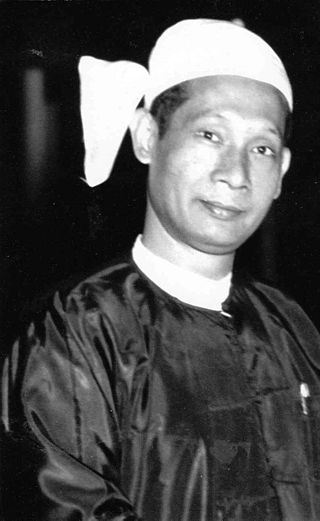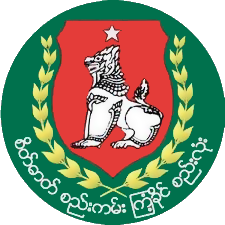The history of Myanmar covers the period from the time of first-known human settlements 13,000 years ago to the present day. The earliest inhabitants of recorded history were a Tibeto-Burman-speaking people who established the Pyu city-states ranged as far south as Pyay and adopted Theravada Buddhism.

Nu, commonly known as U Nu and also by the honorific name Thakin Nu, was a leading Burmese statesman and nationalist politician. He was the first Prime Minister of Burma under the provisions of the 1947 Constitution of the Union of Burma, from 4 January 1948 to 12 June 1956, again from 28 February 1957 to 28 October 1958, and finally from 4 April 1960 to 2 March 1962.

The Anti-Fascist People's Freedom League (AFPFL) was the dominant political alliance in Burma from 1945 to 1958. It consisted of political parties and mass and class organizations.

The University of Yangon, located in Kamayut, Yangon, is the oldest university in Myanmar's modern education system and the best known university in Myanmar. The university offers mainly undergraduate and postgraduate degrees programs in liberal arts, sciences and law. Full-time bachelor's degrees were not offered at the university's main campus after the student protests of 1996. The bachelor's degree was re-offered from 2014 on, to the best students in the country. Today degrees in Political Science are offered to undergraduate students, as well as postgraduate diplomas in areas such as social work and geology.

Ba Swe was the second Prime Minister of Burma. He was a leading Burmese politician during the decade after the country gained its independence from Britain in 1948. He held the position of prime minister from 12 June 1956 to 28 February 1957. When Ba Swe became prime minister, Time magazine reported the news in an article titled: 'The Day of the Tiger' based on his nickname 'Big Tiger' since his university days in the 1930s as a student leader.
Brigadier General Aung Gyi was a Burmese military officer and politician. He was a cofounder of the National League for Democracy and served as president of the party.

The Burma Workers Party, until 1958 the Burma Workers and Peasants Party, was a communist party in Burma, formed on 8 December 1950 by leftist elements of the Socialist Party. In December 1962 it merged with the People's Comrade Party to form the United Workers Party. In March 1964, it was among the many parties banned by decree of the Revolutionary Council.

Dobama Asiayone, commonly known as the Thakhins, was a Burmese nationalist group formed around the 1930s and composed of young, disgruntled intellectuals. Drawing their name from the way in which the British were addressed during colonial times, the party was established by Ba Thaung in May 1930, bringing together traditionalist Buddhist nationalist elements and fresh political ideals. It was significant in stirring up political consciousness in Burma, and drew most of its support base from students.

The Communist Party of Burma (CPB), also known as the Burma Communist Party (BCP), is a clandestine communist party in Myanmar (Burma). It is the oldest existing political party in the country.

The Union Solidarity and Development Party is a political party in Myanmar, registered on 2 June 2010 by the Union Election Commission and currently standing as the largest opposition party in the bicameral Assembly of the Union. It is the successor to the formerly ruling military junta's mass organisation, the Union Solidarity and Development Association. The party was headed by President Thein Sein until 2013, and its headquarters are in Naypyidaw's Dekkhinathiri Township. It is known for its close ties with the military and most of the party officials are former military personnel. The party supported the 2021 Myanmar coup d'état, as well as the military junta during the subsequent protests by the public.
Maung Maung Gyi was an early watercolor painter from Yangon and the first Burmese to travel abroad for studies in Western painting.

General elections were held in Burma on 9 November 1932, having originally been planned for 29 October. The election was held almost solely on the issue of whether Burma should separate from India, as the British government had indicated that it would take the outcome of the elections as an indication of Burmese opinion. Prior to the elections many of the major parties joined either the Anti-Separation League or the Separation League.

Legislative Council elections were held in Burma on 21 November 1922, the first in the country's history.

Elections to the Legislative Council were held in Burma on 17 November 1925. Under the terms of the dyarchy constitution, the Legislative Council of Burma was advisory to the British colonial governor, and had some direct authority over education, local government, public health, agriculture and forests. The Nationalist Party received the most votes, but was unable to form a government as the British authorities favoured the Independent Party, who formed a government led by Joseph Augustus Maung Gyi.
The Legislative Council of Burma was the legislative body of British Burma from 1897 to 1936.
Colonel Kyi Maung was a Burmese Army officer and politician. Originally a member of the military-backed Union Revolutionary Council that seized power in 1962, Kyi Maung resigned from the ruling council in 1963 after a public disagreement with General Ne Win, the leader of the council, on the military's long-term role in government. He joined the National League for Democracy, led by Aung San Suu Kyi, in 1988 and won a seat in the Hluttaw from Bahan Township in the 1990 general election. He was vice-chairman of the NLD from 1988 to 1997. He was imprisoned four times for a total of 12 years by successive military governments.

The 21 Party was a political party in Burma in the 1920s led by U Ba Pe.

The United GCBA, also known as the Ngawbinwsaing, was a political party in Burma led by U Ba Pe.

The communist insurgency in Burma was waged primarily by the Communist Party of Burma and the Communist Party (Burma) from 1948 to 1989. The conflict ended when the CPB, severely weakened by an internal mutiny, disbanded its armed wing.










